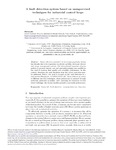A fault detection system based on unsupervised techniques for industrial control loops

Use this link to cite
http://hdl.handle.net/2183/35204Collections
- Investigación (EPEF) [590]
Metadata
Show full item recordTitle
A fault detection system based on unsupervised techniques for industrial control loopsAuthor(s)
Date
2019-08Citation
Jove E, Casteleiro-Roca J-L, Quintián H, Méndez-Pérez JA, Calvo-Rolle JL. A fault detection system based on unsupervised techniques for industrial control loops. Expert Systems. 2019; 36:e12395. https://doi.org/10.1111/exsy.12395
Abstract
[Abstract] This research describes a novel approach for fault detection in industrial processes, by means of unsupervised and projectionist techniques. The proposed method includes a visual tool for the detection of faults, its final aim is to optimize system performance and consequently obtaining increased economic savings, in terms of energy, material, and maintenance. To validate the new proposal, two datasets with different levels of complexity (in terms of quantity and quality of information) have been used to evaluate five well-known unsupervised intelligent techniques. The obtained results show the effectiveness of the proposed method, especially when the complexity of the dataset is high.
Keywords
Power cell
Fault detection
Anomaly detection
One-class
Fault detection
Anomaly detection
One-class
Description
Manuscrito aceptado
Editor version
ISSN
1468-0394





